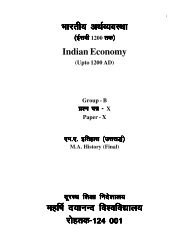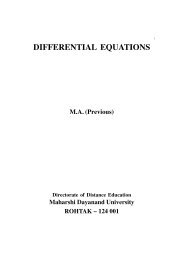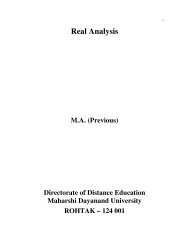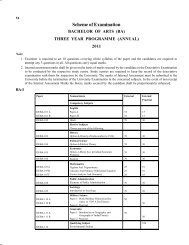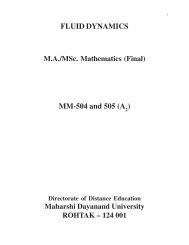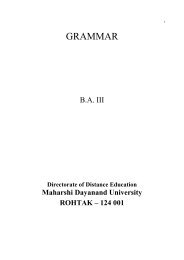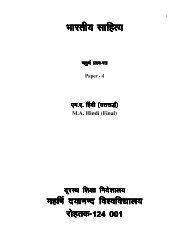Advanced Abstract Algebra - Maharshi Dayanand University, Rohtak
Advanced Abstract Algebra - Maharshi Dayanand University, Rohtak
Advanced Abstract Algebra - Maharshi Dayanand University, Rohtak
Create successful ePaper yourself
Turn your PDF publications into a flip-book with our unique Google optimized e-Paper software.
UNIT-V<br />
137<br />
element of<br />
defines a permutation of the roots of f(x) that lie in K.<br />
as σbg= α α V α ∈k so σf = σ . Hence<br />
f(x)<br />
is one-to-one so<br />
See Proof of the theorem : Topics in <strong>Algebra</strong>, by Hersteim.<br />
Theorem 10.<br />
The general polynomial of degree<br />
Note:<br />
Proof:<br />
are roots of f(x). Sinc there are only finitely many roots of<br />
defines a permutation of those roots of f(x) that lie in K).<br />
is not solvable by radicals.<br />
is called general polynomial of degree over k.<br />
If F(a 1<br />
, a 2<br />
, -------a n<br />
) is the field of rational functions in the n variables a 1<br />
, a 2<br />
, -------a n,<br />
then the Galois group of<br />
n n−1 the polynomial f ( x) = x + a1x + − − − − −a<br />
over F(a<br />
n<br />
1<br />
, a 2<br />
, -------a n<br />
) is S n<br />
, the symmetric group of degree<br />
n (see thu 5.6.3, Hersteins Topics in <strong>Algebra</strong>). But S n<br />
is not solvable group when n ≥ 5 . Hence by thu 9, f(x)<br />
is not solvable by radicals over F(a 1<br />
, a 2<br />
, -------a n<br />
) when .<br />
Summary of basic results, questions and examples:<br />
1. Let F be a subfield of a field K. K may be regarded as a vector space over F. If is a finite dimensional<br />
vector space, we call K a finite extension of F. If the dimension of the vector space K is n, we say<br />
G ne<br />
Θ f<br />
σ<br />
bg ∈<br />
Ga xσ n<br />
k<br />
∈ jG K n<br />
( ≥ K i<br />
5 2 −1<br />
that n-1 K is an extension of degree n over F. We write<br />
∴ 1, c, Q) c<br />
e= , x− k2 jj− + : −a kQ<br />
−j 1, x−=<br />
f,<br />
bg 2a c+ i<br />
−= −0 − − − σac nf −bg<br />
1 ax +<br />
i ha<br />
= n<br />
, 0a i<br />
∈b σk<br />
fgbg<br />
cσ ai h= 0 fcσ<br />
bg ai<br />
h=<br />
0<br />
[K : F] = n<br />
2. Let<br />
This is read, "the degree of K over F is equal to n."<br />
n. Then n elements<br />
be algebraic over F and let p(x) be the minimal polynomial of e over F. Let degree of p(x) be<br />
are linearly independent over F and generate the smallest<br />
field F(c) which contains F and e. Now F(e) is a vector space of dimension n over the field F. Hence the<br />
degree of F(c) over F is equal to the degree of the minimal polynomial of e over F.<br />
bg<br />
Example 1.<br />
F c : F = deg I F,<br />
C<br />
Q 2<br />
rr<br />
b g<br />
e j : Q = deg of irreducible<br />
polynomial p(x) = x 2 –2 over Q = deg Irr eF<br />
, 2j.<br />
.<br />
3. If K is a finite extension of F and K = F(a 1<br />
, a 2<br />
, -------a n<br />
), then a 1<br />
, a 2<br />
, -------a n<br />
have to be algebraic over<br />
F.<br />
This is a consequence of important theorem:



